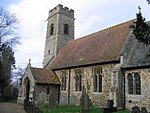Surlingham
AC with 0 elementsCivil parishes in NorfolkEngvarB from July 2016South NorfolkVillages in Norfolk

Surlingham is a village and civil parish in the South Norfolk district of Norfolk situated on the Broads in eastern United Kingdom. It lies approximately 6½ miles (10½ km) south-east of Norwich on the south bank of the River Yare between Bramerton and Rockland St Mary. In the 2001 census it contained 266 households and a population of 637, increasing to 725 at the 2011 census. Although Surlingham is part of South Norfolk District, as in other broadland villages those areas of the village adjacent to the river and broads fall into the executive area of the Broads Authority.
Excerpt from the Wikipedia article Surlingham (License: CC BY-SA 3.0, Authors, Images).Surlingham
School Lane, South Norfolk
Geographical coordinates (GPS) Address Nearby Places Show on map
Geographical coordinates (GPS)
| Latitude | Longitude |
|---|---|
| N 52.6068 ° | E 1.4154 ° |
Address
School Lane
NR14 7DA South Norfolk
England, United Kingdom
Open on Google Maps









